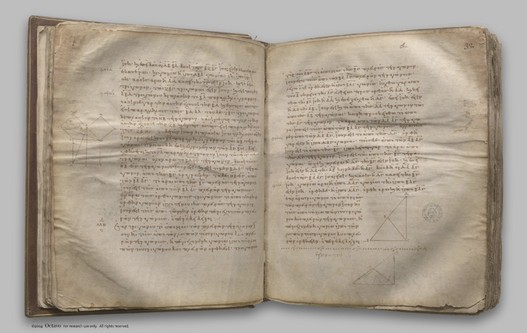The thirteen books of Euclid's Elements
The index below refers to the thirteen books of Euclid's
Elements (ca. 300 BC), as they appear in the "Bodleian Euclid."
This is MS D'Orville 301, copied by Stephen the Clerk for Arethas of Patras,
in Constantinople in 888 AD.
The manuscript now resides in the Bodleian Library, Oxford University.
Each book below contains an index by proposition to the manuscript
images and to corresponding Greek and English text.
The text comes from Heiberg and Heath, respectively. CMI
wishes to recognize Mark Schiefsky and David Camden for this
contribution. (See the acknowledgments
below for the many institutions and people who have contributed to this project.)
Note that your browser must be set to Unicode UTF-8 text encoding
to properly view the Greek text. Try the Text or Character encoding
item in the View menu of your browser.
The manucript was digitized at Oxford in the Fall of 2004 by
Octavo.com with funds provided by the Clay Mathematics
Institute. The work was carried out under the supervision of
Czeslaw Jan Grycz of Octavo and Richard Ovenden of the Bodleian
Library.
Octavo.com, now rarebookroom.org, is a
digital library of rare books established by Dr. John Warnock.
Libraries Without Walls, Inc. continues the digitization
activities begun by Octavo under a non-profit structure. See:
www.librarieswithoutwalls.org. All
the digital collections of this manuscript derive from the
2004 digitization effort.
The Clay Mathematics Institute (CMI) expresses its thanks to the
Bodleian Library and Octavo.com for making these digital
resources available to the interested public, educators,
mathematicians, and historians. CMI is grateful to Mark Schiefsky and David Camden for
providing the index by propositions keyed to the manuscript.
The index to the images was constructed by Camden using a
tool developed by Schiefsky. Schiefsky developed a prorgram
which he used to construct the references to the Greek and
English text. See Archimedes
Project at Harvard University for further information.
The digital text (Greek and English) that is used here is the
result of the Perseus
Project at Tufts University. It was supported by National
Science Foundation.
Clay Mathematics Institute Historical Archive
Published May 8, 2008. Copyright 2008, Clay
Mathematics Institute
Clay Mathematics Institute Historical Archive

Editorial Board
- James A. Carlson, Clay Mathematics Institute
- Bil Casselman, Mathematics Department, University of British Columbia
- Czeslaw Jan Grycz, Libraries Without Walls
- Richard Ovenden, Bodleian Library, Oxford University
- Mark Schiefsky, Classics Department, Harvard University
- Yuri Tschinkel, Courant Institute for Mathematical Sciences,
Mathematisches Institut, Universitaet Goettingen
Links
Interim permissions policy
Permissions policy. (1) Personal use is unrestricted. (2) If the
images are disseminated in any form (via web site, print publication,
or any other means), you must request permission for use via email to
admin@claymath.org. Permission for use in scholarly publications
is routinely and quickly granted. (3) Use of the images must be
accompanied by the one-line notice "Image courtesy of the Clay
Mathematics Institute". (4) Commercial use will be granted on a
case-by-case basis and after execution of a royalty agreement.
Plans
We plan to add both scholarly commentary and popular articles to this site.
